Skype: neodalle-travel
Tel: +86 135 7447 2266
E-mail: sales@visitaroundchina.com

Tujia includes Northern Tujia ( also known as Bifzivkar) and Southern Tujia ( also known as Mongrzzir ). The endonym Bizika means "native dwellers". In Chinese, Tujia means also "local", as distinguished from the Hakka whose name implies wandering.With a total population of over 8 million, is the 8th largest ethnic minority in China.
Where to see Tujia Ethnic Minority?
The Tujia Minority People mainly live in the Wuling Mountains, straddling the common borders of Hunan, Hubei, Guizhou Provinces, and Chongqing Municipality.
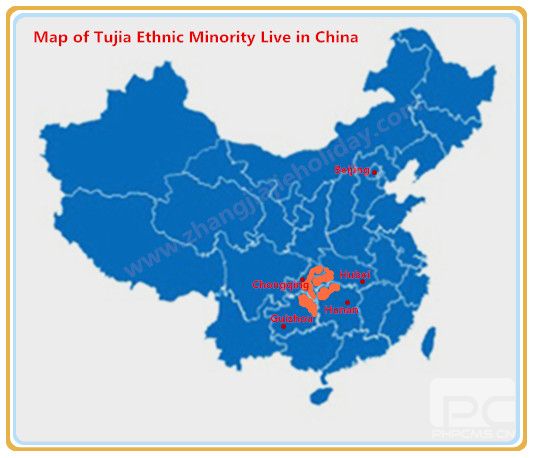 Please check the map! In the Wuling Range of western Hunan and Hubei provinces, at elevations from 400 to 1,500 meters, dwell 8,028,133 people called the Tujias. They live mainly in the Xiangxi Tujia-Miao Autonomous Prefecture, Exi Tujia-Miao Autonomous Prefecture and some counties in southeastern Hunan and western Hubei. In these areas, the climate is mild but rainy, and the land is well-forested.
Please check the map! In the Wuling Range of western Hunan and Hubei provinces, at elevations from 400 to 1,500 meters, dwell 8,028,133 people called the Tujias. They live mainly in the Xiangxi Tujia-Miao Autonomous Prefecture, Exi Tujia-Miao Autonomous Prefecture and some counties in southeastern Hunan and western Hubei. In these areas, the climate is mild but rainy, and the land is well-forested.
The Youshui, Fengshui and Qingjiang rivers intersect there, and on the terraced mountainsides and in the green valleys grow rice, maize, wheat and potatoes. Cash crops include beets, ramie, cotton, tung oil, oil tea and tea, with oil tea and tung oil playing key commercial roles. Timber includes pine, China fir, cypress and the nanmu tree. The area is rich in rare medicinal herbs, minerals, aquatic products and giant salamanders.
About 20,000-30,000 people living in remote areas such as Longshan speak Tujia, a language which is similar to that spoken by the Yis and belongs to the Chinese-Tibetan language system. But the large majority has come to speak the Han and Miao languages, now that the Tujias have been largely assimilated. Their clothing and customs are very much like those of the Hans. Old Tujia ways survive only in remote area.
History of Tujia Minority
There are several conflicting versions of the origin of the Tujias. Some say they are the descendants of the ancient Ba people; others claim they come from the Wuman, who moved to western Hunan from Guizhou Province; yet another tale claims they came from Jiangxi Province in the east at the end of the Tang Dynasty (618-907). In any case, the Tujias were a distinct ethnic group in western Hunan by the early Five Dynasties period, around the year 910. After early contact with Hans, they developed metal smelting and commercial crafts.
Han peasants migrated to western Hunan in the early 12th century, bringing with them modern tools and farming expertise. In western Hubei, feudal lords sold some of their lands to Han peasants and businesspeople, some of whom became landlords. The feudal lords also commanded the economy. So the Tujias were exploited by their own chieftains, feudal lords and Han landlords.
During the Ming Dynasty (1368-1644), Tujia soldiers, together with Han, Zhuang, Miao, Yao, Mulam and Hui fighters, were sent to the country's coastal provinces to fight against Japanese pirates pillaging the areas.
Life Style of Tujia Minority
Food
Tujia people mainly eat rice as their staple food, other miscellaneous grains, such as corns, and sweet potatoes, potatoes, etc.Tujia cuisines are predominated by dishes like Tujia hot pot and tuanniancai. Tujia specialties such as ge fen (Kudzu root powder) , rice wine, cold noodles and Ciba ( a kind of pie made from Glutinous rice) are very tasty. In addition, "Tujia niancai" means that some dishes are only presented on the eve of the spring festival, including steamed meat , chicken soup with chestnuts, preserved fish, etc. Tujia hot pot is usually the favorite of all family members.
Clothing
Traditionally, Tujia women wear jackets trimmed with lace, and with short, broad sleeves. They wear long skirts, and wrap their coiled hair in cloth. They adorn themselves with necklaces, earrings, bracelets and ankle bracelets. Tujia men wear short jackets, with many buttons in front. The traditional hand-woven "xi" and "tong" cloth, with intricate designs, is the main material for clothing.
Living Quarters
The Tujia ethnic minority boasts a distinct architectural style; hanging cottages built on hillsides, and supported by pillars. The houses of the Tujia are also known as Diaojiaolou .On the lower floor, there is livestock; while the girls' bedrooms are kept upstairs. This design focuses on the use of small rooms but is also well ventilated, clean, and damp resistant.
Festivals
The grandest festival is the Tujia Year is called 'Gannian' or 'Diaonian Meeting', and is celebrated one day before the lunar New Year of the Han people. On that day, people prepare sumptuous dinners, and dance together. They also celebrate the Dragon Boat Festival, Sheri (on the second day of the second lunar month), and some others, as well. Among them, the "Diaonian Meeting", "Zhongwu Holiday", and "Guozu Festival" are the three most important holidays the Tujia people celebrate in a year.
Customs of Tujia Minority
Tujia people are well known for their custom of a crying marriage, which they view as a necessary marriage procedure. The bride may cry in different ways with diversified words, which is also called "Crying Marriage Song"; the somewhat exaggerated singing helps to enhance the wedding atmosphere. Crying at wedding is a customary way to set off the happiness of the wedding, via falsely sorrowful words.
Tujias also have some rather distinctive taboos. Young girls or pregnant women are not permitted to sit on thresholds, while men cannot enter a house wearing straw raincoats, carrying hoes, or carrying empty buckets. Nor are people allowed to approach the communal fire, or to say ostensibly unlucky things, on auspicious days.
Religious beliefs of the Tujia minority include Taoism, ancestor worship, and a shamanistic belief in gods, ghosts, and demons. Formerly, prayers were said before hunting, and when a person died, wizards were invited to expel evil spirits and ghosts from the house.
Culture & Arts of Tujia Minority
Tujia people have their own language, which belongs to the Tibeto-Burman group of the Chinese-Tibetan language family. As they have no written script, they use Chinese characters, instead, and the large majority has come to speak the Han and Miao dialects. Tujia ethnic minority is influenced greatly by the Hans, and mainly engaged in agriculture. Diligent and courageous, the Tujias have created a colorful and unique culture and arts.
Maogusi Dance,Maogusi means "men with a lot of fur" in the Tujia dialect. The dance originated from the sacrificial ceremony of the ancient Tujia people. It's the most primitive and roughest type of Tujia Dance. Experts consider it to be a living fossil of Chinese operas. It reflects the ancient, primitive activities of the Tujias: hunting, fishing, farming, etc. All the dancers dress in clothing made from straw.
Hand-waving Dance is the most popular, ancient dance of the Tujia people. In the past, it was a kind of martial dance, used when fighting with an enemy. It lasts from the beginning of January to the 17th of the lunar calendar. Hundreds or thousands people perform the dance, all dressed in splendid attire, singing, dancing, and beating drums and gongs, at night. At these times, all Tujias are immersed in a warm and lively atmosphere.
Tujia Brocade was also named Xilan Kapu. It's made by hand and has a history of about 2,000 years. In Tujia language "Xilan" means "bedcover" and "Kapu" means "flower". So originally, Xilan Kapu is a kind of bedcover which was decorated with raised designs of flowers. It has now developed into a work of art, which takes various forms, including clothes, bags, carpets, and sachets.
Attractions of Tujia Minority
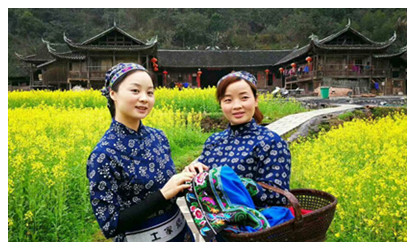 |
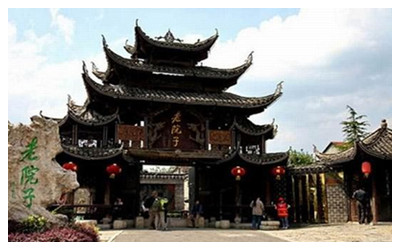 |
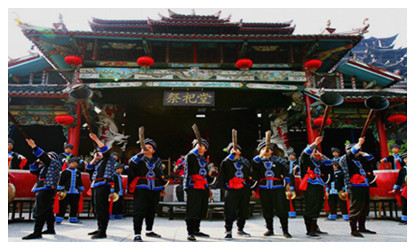 |
| Shiyanping Tujia Village | Tian's Old Courtyyard | Tujia Ethnic Customs Park |
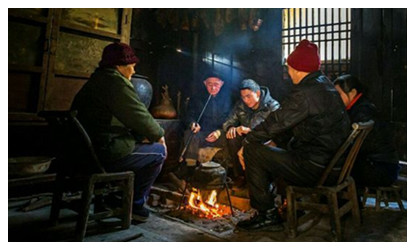 |
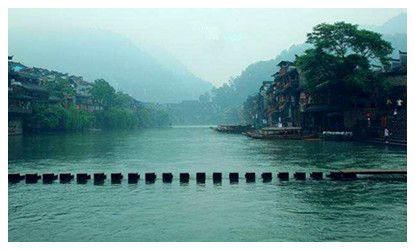 |
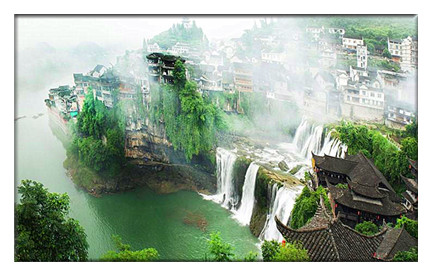 |
| Changtiai Tujia Village | Fenghuang Ancient Town | Furong Ancient Town |
 Ask Questions ?
Ask Questions ?